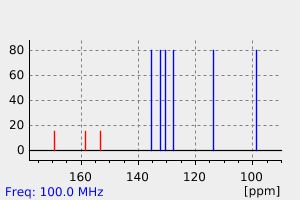2H-环戊并(b)呋喃-2-酮 | 4481-35-0
中文名称
2H-环戊并(b)呋喃-2-酮
中文别名
——
英文名称
cyclohepta[b]furan-2(2H)-one
英文别名
2H-cyclohepta[b]furan-2-one;2H-Cyclohepta(b)furan-2-one;cyclohepta[b]furan-2-one
CAS
4481-35-0
化学式
C9H6O2
mdl
MFCD08458960
分子量
146.145
InChiKey
LBFAKLHYVDQHRO-UHFFFAOYSA-N
BEILSTEIN
——
EINECS
——
-
物化性质
-
计算性质
-
ADMET
-
安全信息
-
SDS
-
制备方法与用途
-
上下游信息
-
文献信息
-
表征谱图
-
同类化合物
-
相关功能分类
-
相关结构分类
计算性质
-
辛醇/水分配系数(LogP):1.6
-
重原子数:11
-
可旋转键数:0
-
环数:2.0
-
sp3杂化的碳原子比例:0.0
-
拓扑面积:26.3
-
氢给体数:0
-
氢受体数:2
安全信息
-
海关编码:2932209090
SDS
上下游信息
-
上游原料
中文名称 英文名称 CAS号 化学式 分子量 —— 3-chloro-2H-cycloheptafuran-2-one 18523-40-5 C9H5ClO2 180.59 -
下游产品
中文名称 英文名称 CAS号 化学式 分子量 —— 3-chloromethyl-2H-cycloheptafuran-2-one 157364-77-7 C10H7ClO2 194.617 —— 3-hydroxymethyl-2H-cycloheptafuran-2-one 157364-78-8 C10H8O3 176.172 —— 2-oxo-2H-cycloheptafuran-3-carbaldehyde 157364-76-6 C10H6O3 174.156
反应信息
-
作为反应物:描述:2H-环戊并(b)呋喃-2-酮 在 碳酸氢钠 、 三氟乙酸 、 2,3-二氯-5,6-二氰基-1,4-苯醌 作用下, 以 二氯甲烷 、 乙腈 为溶剂, 反应 26.5h, 生成 bis(2-oxo-2H-cyclohepta[b]furan-3-yl)methoxymethane参考文献:名称:双(杂zu烯-3-基)甲基阳离子和双(杂zu烯-3-基)酮的合成及性能摘要:新型双(杂氮杂烯基-3-基)甲基阳离子,双(2-氧代-2 H-环庚[ b ]呋喃-3-基)甲基阳离子盐和氮类似物的合成与性质,(9a – c ·PF 6 - )和(9A - ç ·BF 4 - ),以及双(heteroazulen -3-基)酮(12A - d)进行了研究。合成方法是基于TFA催化的杂多烯(6a - d)上的多聚甲醛亲电取代,得到相应的二取代甲烷衍生物7a - d,然后用DDQ氧化氢抽象,然后使用aq。交换抗衡阴离子。HPF 6或水溶液 HBF 4。此外,7a - d与2.2当量的反应。一定数量的DDQ得到羰基化合物12a - d。通过1 H和13 C NMR光谱数据评估9a – c正电荷的离域。阳离子9a – c的热力学稳定性经评估为9a < 9b < 9c根据通过循环伏安法(CV)测量的还原电位和分光光度法获得的p K R +值(2.6–10.3)。阳离子9a – c的DOI:10.1016/s0040-4020(03)00546-5
-
作为产物:描述:2-(ethoxycarbonylmethyl)-2,4,6-cyclohepta-2,4,6-trien-1-one 反应 1.0h, 以56%的产率得到2H-环戊并(b)呋喃-2-酮参考文献:名称:Eine verbesserte Synthese des 2-Oxocyclohepta[b]furans摘要:DOI:10.1055/s-1983-30586
-
作为试剂:描述:四氢吡咯 、 magnesium sulfate 、 1-[4-(benzyloxy)-3-bromophenyl]acetone 在 乙醇 、 2H-环戊并(b)呋喃-2-酮 、 silica gel 、 ethyl acetate n-hexane 作用下, 以 乙醚 为溶剂, 反应 20.0h, 以to obtain 2-[4-(benzyloxy)-3-bromobenzyl]azulene (0.84 g)的产率得到2-[4-(benzyloxy)-3-bromobenzyl]azulene参考文献:名称:Azulene derivatives and salts thereof摘要:本发明提供一种蓝花烃衍生物及其盐,其中蓝花烃环直接或通过可被卤素原子取代的较低烷基与苯环结合,苯环直接与葡萄糖残基结合,可用作Na+-葡萄糖共转运体抑制剂,特别是用于治疗和/或预防糖尿病,如胰岛素依赖性糖尿病(1型糖尿病)和非胰岛素依赖性糖尿病(2型糖尿病),以及糖尿病相关疾病,如胰岛素抵抗性疾病和肥胖症。公开号:US07169761B2
文献信息
-
Conjugate addition of an ynone containing azulene with a tertiary amine作者:Jun-ichi Yamaguchi、Sayuri SugiyamaDOI:10.1016/j.tetlet.2016.08.094日期:2016.10azulene with tertiary amines resulted in transformation of the corresponding enaminone in high yield. The product ratio depended on the group at the structure of the amine. Investigation of the reaction mechanism indicated that treatment of the ynone with a tertiary amine gave the corresponding ammonium salt, followed by removal of an alkyl group to form the enaminone as the final product. The color of the
-
Synthesis and Analysis of Positive Inotropic Effects of 3-Substituted-2H-cyclohepta(b)furan-2-one Derivatives.作者:Masayuki YOKOTA、Takashi YANAGISAWA、Kazuhiro KOSAKAI、Shuichi WAKABAYASHI、Tsuyoshi TOMIYAMA、Masafumi YASUNAMIDOI:10.1248/cpb.42.865日期:——Several 3-substituted-2H-cyclohepta[b]furan-2-one derivatives were prepared and tested in vitro for positive inotropic character. Introduction of an isopropyl group at the 5-position of compound 8a caused an increase of PIC50 (negative logarithm of the dosage which increases the contractile force by 50%) from 4.48 to 5.10. Among the 5-isopropyl-8-alkoxy compounds, the isopropoxy compound 12f had the most potent activity with a PIC50 value of 5.99. Conversion of the ester group at the 3-position to a methylene group and of the alkoxy group at the 8-position to a substituted amino group caused a decrease in activity. The most active compound, 12f, was also found to have a weaker heart rate (HR)-increasing effect compared to milrinone and amrinone.
-
Synthesis of Polyalkylphenyl Prop-2-ynoates and Their Flash Vacuum Pyrolysis to Polyalkylcyclohepta[b]furan-2(2H)-ones作者:Matthias Nagel、Hans-Jürgen HansenDOI:10.1002/(sici)1522-2675(20000510)83:5<1022::aid-hlca1022>3.0.co;2-y日期:2000.5.10A new method for the smooth and highly efficient preparation of polyalkylated aryl propiolates has been developed. It is based on the formation of the corresponding aryl carbonochloridates (cf. Scheme 1 and Table 1) that react with sodium (or lithium) propiolate in THF at 25 – 65°, with intermediate generation of the mixed anhydrides of the arylcarbonic acids and prop-2-ynoic acid, which then decompose开发了一种平稳高效制备多烷基化芳基丙酸酯的新方法。它基于形成相应的芳基碳酰氯(参见方案 1 和表 1),其与 THF 中 25-65° 的丙醇钠(或锂)反应,中间生成芳基碳酸和丙醇的混合酸酐-2-ynoic acid,然后几乎定量地分解成 CO2 和芳基丙酸酯(参见方案 11)。该过程优于将丙炔酸转化为其难以处理的酰氯,然后与芳醇钠(或锂)反应。许多多烷基化芳基丙炔酸酯在 600 – 650° 和 10-2 Torr 下进行闪蒸真空热解 (FVP),导致形成相应的环庚[b]furan-2(2H)-ones,平均产率为25 – 45%(参见方案 14)。在中试实验中进一步发现,多烷基化的 cyclohepta[b]furan-2(2H)-ones 与甲苯中的 1-(pyrrolidin-1-yl)cyclohexene 在 120 – 130° 下反应生成相应的 1,2, 3,4-四氢苯并[
-
Direct synthesis of 2-arylazulenes by [8+2] cycloaddition of 2<i>H</i>-cyclohepta[<i>b</i>]furan-2-ones with silyl enol ethers作者:Taku Shoji、Shuhei Sugiyama、Yoshiaki Kobayashi、Akari Yamazaki、Yukino Ariga、Ryuzi Katoh、Hiroki Wakui、Masafumi Yasunami、Shunji ItoDOI:10.1039/c9cc09376a日期:——We developed a procedure for the direct synthesis of 2-arylazulenes, which were obtained in moderate to excellent yields, by [8+2] cycloaddition of 2H-cyclohepta[b]furan-2-ones with aryl-substituted silyl enol ethers. The structures of some 2-arylazulenes were clarified by single-crystal X-ray analysis. The 2-phenylazulene derivatives obtained by this study showed noticeable fluorescence in acidic
-
A Versatile Synthetic Method of 1-Alkylazulenes and Azulene by the Reactions of 3-Methoxycarbonyl-2<i>H</i>-cyclohepta[<i>b</i>]furan-2-one with<i>in situ</i>Generated Enamines作者:Masafumi Yasunami、Shiro Miyoshi、Noriko Kanegae、Kahei TakaseDOI:10.1246/bcsj.66.892日期:1993.3Methyl 3-alkylazulene-1-carboxylates were synthesized in high yields by the reaction of 3-methoxycarbonyl-2H-cyclohepta[b]furan-2-one with in situ generated morpholine enamines of aldehydes. Treatment of the esters with 100% phosphoric acid gave 1-alkylazulenes in excellent yields. Azulene was also synthesized in a good yield via methyl azulene-1-carboxylate with a modification of this method.
表征谱图
-
氢谱1HNMR
-
质谱MS
-
碳谱13CNMR
-
红外IR
-
拉曼Raman
-
峰位数据
-
峰位匹配
-
表征信息
同类化合物
[2-二(2,4-二叔-丁基苯氧基)磷烷氧基-3,5-二叔-丁基-苯基]-氯-钯
N-(2-氰基乙基)-N-(2-吗啉-4-基乙基)-4-羰基-9,10-二氢-4H-苯并[4,5]环庚三烯并[1,2-b]呋喃-3-甲酰胺盐酸
N-(2-(二乙胺)乙基)-4-((2-(二乙胺)乙基)氨基)-9,10-二氢-4-羟基-4H-苯并(4,5)环庚三烯并[1,2-b]呋喃-3-甲酰胺
N,N-二乙基-4-羰基-9,10-二氢-4H-苯并[4,5]环庚三烯并[1,2-b]呋喃-3-甲酰胺
6H-2-氧杂薁-6-酮
5-甲基-2,3-二氢-7H-呋喃并[3,2-g]色烯-7-酮
5-异丙基-3-(甲氧羰基)-2H-环庚烷[b]呋喃-2-酮
3-乙酰基-2H-环庚并[b]呋喃-2-酮
3-(甲氧羰基)-2H-环庚[b]呋喃-2-酮
3,5,8-三甲基薁并[6,5-b]呋喃
2H-环戊并(b)呋喃-2-酮
2,7,8,9-四氢-6-甲基-9-亚甲基-2-氧代薁并[4,5-b]呋喃-3-甲醛
(8R)-1,5,8-三甲基-7,8-二氢-6H-薁并[7,6-D]呋喃-2-酮
(5aR,6S)-rel-(-)-5,5a,6,10-四氢-5a,6-二甲基-4H-苯并(5,6)环庚并(1,2-b)呋喃
(3R,5Z,7E)-3,25-二羟基-9,10-裂胆甾-5,7,10-三烯-23-酮
(2Z)-3-甲基-N-苯基-2H-环庚并[b]呋喃-2-亚胺
3-Methyl-8-hydroxy-2H-cycloheptafuran-2-on
5-bromo-1,3-di-tert-butyl-4,4,6-trimethyl-4H-cyclopenta[c]furan
2-Methyl-7-propylcycloheptafuran-8-on
4-methoxy-2,3,6-trimethyl-8,9-dihydro-furo[2,3-f]isoquinoline
3-(3,4-dihydro-2H-naphthalen-1-ylidenemethyl)furan
(4α,4aβ,5α,7α,7aα,8α,9β)-(+/-)-9-<<(1,1-dimethylethyl)dimethylsilyl>oxy>-4,4a,5,6,7,7a,8,9-octahydro-4a,8-dimethyl-4-(1-ethoxyethoxy)-5-<(2-methoxyethoxy)methoxy>-7-methoxyazuleno<6,5-b>furan
3-bromo-2-(4-fluorophenyl)-5,6-dihydro-4H-benzo[6,7]cyclohepta[1,2-b]furan
1-benzyl-3-ethyl-4,5,6,7-tetrahydroisobenzofuran
(E)-4,4,-dimethyl-3-(3,4-pentano-2-furyl)-2-pentenenitrile
(Z)-4,4-dimethyl-3-(3,4-pentano-2-furyl)-2-pentenenitrile
3,4,3',4'-tetrachloro-6,6'-o-phenylene-bis-pyran-2-one
4-(Furan-2-yl)-3,15-dioxatetracyclo[6.6.1.02,6.09,14]pentadeca-2(6),4,9,11,13-pentaene
4-Methoxy-2-methyl-6,7,8,9-tetrahydro-3-oxa-cyclohepta[e]inden-10-one
2-cyano-3-(5-isopropyl-2-oxo-2H-cyclohepta[b]furan-3-yl)-but-2-enedinitrile
3-cyano-2H-cycloheptafuran-2-one
7,7-Dimethyl-4,5,6,7,8,9-hexahydro-naphtho[2,3-c]furan-5-ol
5-Isopropyl-2-oxo-2H-cyclohepta[b]furan-3-carbonitrile
diethyl 1-phenyl-5-(5,6,7,8-tetrahydro-4H-cyclohepta[c]furan-3-yl)bicyclo[3.1.0]hexane-3,3-dicarboxylate
(4aS,7aS)-6,6-Dimethyl-8-methylene-4,4a,5,6,7,7a,8,9-octahydro-2-oxa-cyclopenta[f]azulene
4,5,6,7-tetrahydro-8H-cyclohepta[b]furan-8-one
ethyl 8-hydroxy-2-oxo-2H-cycloheptafuran-3-carboxylate
2,3-Pentamethylen-5-methoxy-benzofuran
8-Ethoxy-6-(4-methoxy-phenyl)-1,3-dimethyl-cyclohepta[c]furan-4-one
2-((3-((1-(furan-2-ylmethylene)-1H-inden-3-yl)methylene)-2,3-dihydro-1H-inden-1-ylidene)methyl)furan
isognididione
3β,9α,10β-Trihydroxyfuranoeremophilan
3-acetyl-7-isopropyl-cyclohepta[b]furan-2-one
2-(1-ethoxymethyleneamino)-4-(4-methoxyphenyl)-8,10-dimethyl-7-oxo-4H,7H-furo[3',4':6,7]cyclohepta[1,2-b]pyran-3-carbonitrile
furanoeremophilane-3β,9β,10β-triol







